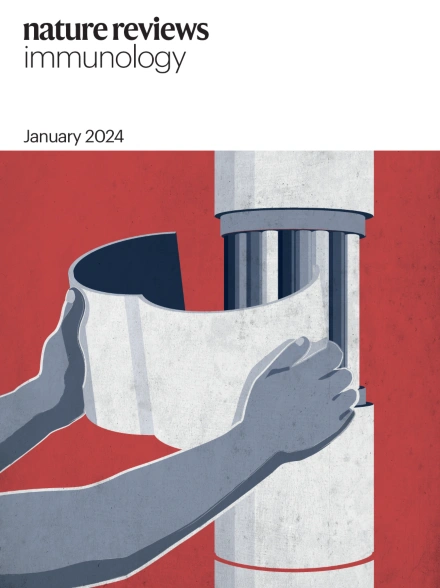Immune control of brain physiology
IF 60.9
1区 医学
Q1 IMMUNOLOGY
引用次数: 0
Abstract
The peripheral immune system communicates with the brain through complex anatomical routes involving the skull, the brain borders, circumventricular organs and peripheral nerves. These immune–brain communication pathways were classically considered to be dormant under physiological conditions and active only in cases of infection or damage. Yet, peripheral immune cells and signals are key in brain development, function and maintenance. In this Perspective, we propose an alternative framework for understanding the mechanisms of immune–brain communication. During brain development and in homeostasis, these anatomical structures allow selected elements of the peripheral immune system to affect the brain directly or indirectly, within physiological limits. By contrast, in ageing and pathological settings, detrimental peripheral immune signals hijack the existing communication routes or alter their structure. We discuss why a diversity of communication channels is needed and how they work in relation to one another to maintain homeostasis of the brain. The peripheral immune system communicates with the brain through diverse anatomical routes to shape brain physiology. Here we discuss why such diversity is needed and explore how these routes are leveraged during development and hijacked in ageing.


脑生理学的免疫控制
外周免疫系统通过复杂的解剖途径与大脑沟通,包括颅骨、脑边界、脑室周围器官和周围神经。这些免疫-脑通讯通路通常被认为在生理条件下处于休眠状态,只有在感染或损伤的情况下才有活性。然而,外周免疫细胞和信号是大脑发育、功能和维持的关键。从这个角度来看,我们提出了另一种理解免疫-脑通讯机制的框架。在大脑发育和体内平衡期间,这些解剖结构允许外周免疫系统的选定元素在生理限度内直接或间接影响大脑。相反,在衰老和病理环境中,有害的外周免疫信号劫持现有的通信路线或改变其结构。我们讨论了为什么需要多种沟通渠道,以及它们如何相互作用以维持大脑的稳态。
本文章由计算机程序翻译,如有差异,请以英文原文为准。
求助全文
约1分钟内获得全文
求助全文
来源期刊

Nature Reviews Immunology
医学-免疫学
CiteScore
93.40
自引率
0.40%
发文量
131
审稿时长
6-12 weeks
期刊介绍:
Nature Reviews Immunology is a journal that provides comprehensive coverage of all areas of immunology, including fundamental mechanisms and applied aspects. It has two international standard serial numbers (ISSN): 1474-1733 for print and 1474-1741 for online. In addition to review articles, the journal also features recent developments and new primary papers in the field, as well as reflections on influential people, papers, and events in the development of immunology. The subjects covered by Nature Reviews Immunology include allergy and asthma, autoimmunity, antigen processing and presentation, apoptosis and cell death, chemokines and chemokine receptors, cytokines and cytokine receptors, development and function of cells of the immune system, haematopoiesis, infection and immunity, immunotherapy, innate immunity, mucosal immunology and the microbiota, regulation of the immune response, signalling in the immune system, transplantation, tumour immunology and immunotherapy, and vaccine development.
 求助内容:
求助内容: 应助结果提醒方式:
应助结果提醒方式:


